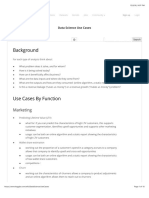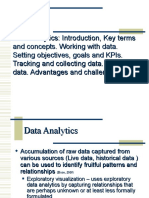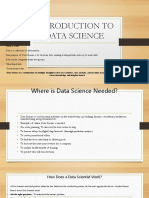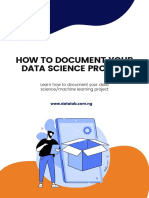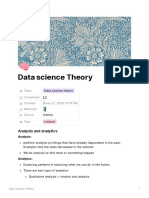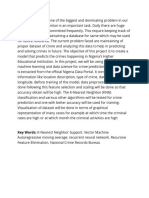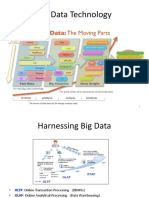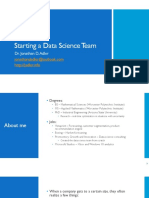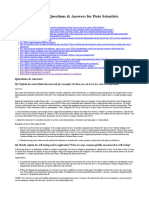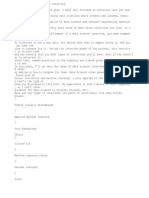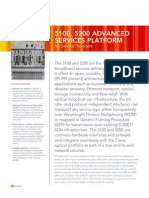hat
Data Science in Practice
Five common applications of data science with concrete,
real-life use cases
Presented by
Yhat
http://yhat.com/
June 2016
hat
| Data Science in Practice
�What is data science...actually?
How do real companies use data science to make products
and operations better?
What does the data science lifecycle look like?
In our first whitepaper, Applied Data Science, we translated the hype-y
term of data science into the plain english definition of using data to
make better decisions, optimize processes and improve products and
services. We also described the central goal of data science: getting
statistical models into production.
In this whitepaper we introduce five common applications of data
science that build upon those concepts. Our goal is to debunk the
impression that data science is some type of obscure black magic and
give you concrete examples of how it is applied in reality. Youll learn how
real companies are using data science to make their products and dayto-day operations better. Last but not least, we describe the data science
life cycle and explain Yhats role in getting models into production.
hat
| Data Science in Practice
�APPLICATION 1:
RECOMMENDER SYSTEMS
Recommender systems, also known as
recommender engines, are one of the most
well known applications of data science.
Recommender systems are a subclass of
information filtering systems, systems that
cut through the noise of all options and
present users with just the subset of options
WHAT IS A RECOMMENDER SYSTEM?
A model that filters information to present users
with a curated subset of options theyre likely to find
appealing
HOW DOES IT WORK?
Generally via a collaborative approach
(considering users previous behavior) or contentbased approach (based on discrete assigned
characteristics)
WHAT IS A REAL USE CASE?
Tendril uses recommendation models to match
eligible customers with new or existing energy
products
theyll find appealing. The data being filtered
can range from products on an e-commerce
approach to filtering. Collaborative filtering
site to dating matches that appear as you
considers a users previous behavior, as well
search for the one.
as the behavior of similar users. Contentbased filtering provides recommendations
Recommender Systems
based on discrete attributes or assigned
characteristics.
Data scientists at energy software company
Content Filtering
(location, age, gender)
Collaborative Filtering
(previous behavior, similar users)
Tendril opted for a hybrid approach that
combines both collaborative and contentbased filtering. Tendril provides analytics
and consumer solutions to energy suppliers,
Recommender
System
including which energy products consumers
would most likely consider. We use Support
Vector Regression models to predict
household energy consumption to provide
our clients with in-depth, personalized
information about their customers, explains
Recommender systems offer a more
Mark Gately, Data Analytics Manager at
intelligent approach to information filtering
Tendril. This detailed information is also
than a simple search algorithm by introducing
used in recommendation models, which help
users to items they might not have otherwise
match eligible customers with new or existing
discovered. Recommender systems generally
energy products.
take either a collaborative or content-based
hat
| Data Science in Practice
�APPLICATION 2:
CREDIT SCORING
One such company is Ferratum Bank,
a pioneer in financial technology and
mobile consumer lending since 2005. We
developed complex statistical and machine
If you have ever applied for a credit card
learning models to enable smarter lending
or a loan, youre likely already familiar with
decisions, explains Scott Donnelly, Director
the concept of credit scoring. What you
of Business Lending at Ferratum Bank. By
may be less aware of is the set of decision
getting creative with our approach and
management rules evaluating how likely
adopting innovative technologies, weve been
an applicant is to repay debts behind the
able to reinvent how both consumers and
scenes.
businesses obtain loans. This has allowed us
to reach prospective customers that in the
WHAT IS CREDIT SCORING?
A model that determines an applicants
creditworthiness for a mortgage, loan or credit card
past may have been overlooked by traditional
HOW DOES IT WORK?
A set of decision management rules evaluates how
likely an applicant is to repay debts
APPLICATION 3:
DYNAMIC PRICING
WHAT IS A REAL USE CASE?
Ferratum Bank uses machine learning models to
reach prospective customers that may have been
overlooked by traditional banking institutions
banking institutions.
You walk out of the store, arms full of
groceries, only to realize that a torrential
downpour began as you perused the
The first general purpose credit scoring
produce inside. You struggle to retrieve your
algorithm, now known as the FICO score, was
phone, check your favorite ride app and are
introduced in 1989. The FICO score is still
dismayed to find...a 2.1x surge!? Welcome to
one of the most widely used models in the
your first lesson on dynamic pricing.
United States today, though peer-to-peer and
direct lending organizations have focused
on developing new techniques over the
past few years. These new machine learning
models and algorithms capture innovative
factors and relationships that traditional
loan scorecards couldnt, like how applicants
manage monthly cash flow or whether
friends or community members would
endorse the applicant.
hat
| Data Science in Practice
WHAT IS DYNAMIC PRICING?
Modeling price as a function of supply, demand,
competitor pricing and exogenous factors
HOW DOES IT WORK?
Generalized linear models and classification trees
are popular techniques for estimating the right
price to maximize expected revenue
WHAT IS A REAL USE CASE?
Turo uses dynamic pricing models to suggest prices
to the people who list and rent out cars
�Businesses use dynamic pricing algorithms
ago we started to model supply and demand
to model rates as a function of supply,
dynamics, so working on dynamic pricing was
demand, competitor pricing, and exogenous
an intuitive next step.
factors (e.g. weather or time). Many fields,
from airline travel to athletics admission
We quickly realized that the gap between
ticketing, employ dynamic pricing to
model development and model deployment,
maximize expected revenue. The nuts and
in production, was much bigger than
bolts of dynamic pricing strategies vary
expected. It requires a very wide spectrum of
widely, though generalized linear models and
skills: from knowledge of statistical modeling
classification trees are popular techniques for
to software architecture best practices. We
estimating the right (lowest/highest) price
use Yhats platform, ScienceOps, to transform
that consumers are willing to pay for a book,
our dynamic pricing prototype into a
a flight, or a cab.
production-ready algorithm in the languages
our Data Science team prefers to work in, R
Dynamic Pricing
Price (e.g. fare of ride)
D2
and Python.
D1
P2
P1
APPLICATION 4:
CUSTOMER CHURN
Churn rate describes the rate at which
customers abandon a product or service.
Understanding customers likelihood to churn
is particularly important for subscription-
Q1
Q2
Quantity (e.g. # of rides)
based models, everything ranging from
traditional cable or gym memberships to
recently popularized monthly subscription
Turo, a peer-to-peer car rental service
operating in over 2,500 cities, uses dynamic
pricing to suggest prices to the people who
list and rent out their cars on the platform.
Dynamic pricing helps us to balance supply
and demand and ensure that both our
travelers and our hosts are getting a fair
market deal, explains Jrme Selles, Director
of Data Science and Analytics. Three years
hat
| Data Science in Practice
boxes.
Data scientists looking to predict customer
churn may consider a variety of algorithms
for the job, such as support vector machines,
random forest, or k-nearest-neighbors.
Beyond the accuracy of a given model, data
scientists must also balance the tradeoff
between precision (correctly predicting a
�churning customer) and recall (how many
not graduating more efficiently, so they can
predictions were actually successful). So
intervene and help those students graduate.
whats better? Classifying every churning
customer but occasionally mislabeling a
non-churning customer? Or identifying fewer
churning customers, but not mislabeling nonchurners? Its a difficult decision that requires
in-depth knowledge of the business case and
years of experience.
APPLICATION 5:
FRAUD DETECTION
Financial technology, or FinTech, companies
offer financial services like banking, investing,
and payment processing via software, rather
than through traditional banking institutions.
WHAT IS CUSTOMER CHURN?
Predicting which customers are going to abandon
a product or service
HOW DOES IT WORK?
Data scientists may consider using support vector
machines, random forest or k-nearest-neighbors
algorithms
WHAT IS A REAL USE CASE?
EAB combines data from transcripts, standardized
test scores, demographics and more to identify
students at risk of not graduating
These are familiar questions for the data
scientists at EAB, the education division of
The Advisory Board Company. EAB provides
data driven applications and insights to
hundreds of institutions of higher education.
A key component of our Student Success
Collaborative product, used by academic
advisors and other administrators, is a
predictive model of student graduation, says
Harlan Harris, Director of Data Science. We
combine data from transcripts, standardized
test scores, demographics, and other facts
about students to provide a graduation
risk score. Colleges and universities use
these scores to identify students at risk of
hat
| Data Science in Practice
Companies processing massive volumes of
financial transactions also need a quantifiable
way to detect and prevent fraudulent
transactions from being processed.
WHAT IS FRAUD DETECTION?
Detecting and preventing fraudulent financial
transactions from being processed
HOW DOES IT WORK?
Fraud detection is a binary classification problem:
is this transaction legitimate or not?
WHAT IS A REAL USE CASE?
Via SMS Group uses a combination of complex
data lookups and decision algorithms written in
R and implemented in PHP to assess whether a
loan applicant is fraudulent
Traditional fraud detection presents a fairly
straightforward problem: Is a transaction
legitimate or not? Otherwise called a binary
classification problem. This can be trickier
than it seems, especially when you have
thousands (or even millions) of legitimate
transactions occurring for every instance
of fraud. To add insult to injury, a single
occurrence of fraud can cost a company an
exorbitant amount of money. To combat this,
�some data science teams pair supervised
data can be used to inform decisions,
classification techniques with anomaly
optimize processes, and improve products
detection algorithms to identify outliers and
and services across a very wide range of
pick out suspicious behavior.
business problems. Regardless of the specific
question at hand, the data science lifecycle
Dmitrijs vovs is responsible for managing
always culminates with selecting the winning
risk at VIA SMS Group, where over 60MM
model strategy and implementing it into an
is loaned to consumers across 6 countries
application where real business value can be
every year. The risk analytics team at VIA
realized.
SMS Group use advanced algorithms to
assess whether an applicant is fraudulent
For data scientists who build their models
prior to considering whether or not to
in open source programming languages
underwrite the requested loan. We write our
like R and Python, the path to production
decision algorithms in the R programming
application is not always clear. Mobile and
language and implement them into our
web applications are built using platforms
web and mobile apps in the server-side
and frameworks like .NET, Ruby on Rails,
language of PHP. By using R, we can leverage
Java, PHP or Node.js, which cannot consume
a combination of complex data lookups
models written in R or Python. As a result,
and state of the art algorithms to identify
many models are abandoned after months
fraudulent transactions, explains Dmitrijs.
of work before they ever see the light of
day. Alternatively, data scientists advanced
THE DATA SCIENCE LIFECYCLE
As the five applications above demonstrate,
statistical procedures may be tossed
over the fence to engineers and manually
recoded into another language, a notably
Now what?
So when can we
go live with the
new model?
hat
| Data Science in Practice
Any of you know
what Gradient
Boosting is?
�difficult, time consuming and error-prone
rely on ScienceOps to take data science
process.
models from prototype to production.
YHATS ROLE
To find out more about how your business
Yhats data science operations
system, ScienceOps, eliminates the
can deploy models rapidly, frequently and
reliably with ScienceOps, get in touch with
the Yhat team or schedule a demo today.
counterproductive barrier between data
scientists and engineers by making R and
Python models accessible via REST API.
Instead of translating models, data scientists
can deploy models to ScienceOps, where
automatically generated API endpoints make
production integration quick & easy.
WHAT IS SCIENCEOPS?
Yhats data science operations system that
eliminates the barrier between data scientists and
engineers
HOW DOES IT WORK?
ScienceOps makes R and Python models accessible
via REST API and provides a platform to monitor,
manage and scale data science models
WHAT IS A REAL USE CASE?
ScienceOps is used by companies around the
globe, including each of those highlighed in the five
applications above
Our core mission at Yhat is to allow data
scientists to deploy predictive models rapidly,
frequently and reliably, but we recognize
that a data scientists job does not end there.
Beyond the initial step of implementing
models, ScienceOps also provides the ability
to monitor, manage and scale models.
Companies around the globe, including each
of those highlighted in the use cases above,
hat
| Data Science in Practice
�Works Cited
Chiang, Eric. Predicting Customer Churn with Scikit-learn. The Yhat Blog. Yhat, 20 Mar. 2014.
Web.
Huang, Cheng-Lung, Mu-Chen Chen, and Chieh-Jen Wang. Credit Scoring with a Data Mining
Approach Based on Support Vector Machines. Expert Systems with Application 33 (2007):
847-56. Web.
Leskovec, Jure, and Jeffrey Ullman. Recommendation Systems. Mining of Massive Data Sets.
Ed. Anand Rajaraman. 2.1 ed. Cambridge: Cambridge UP, 2014. 307-41. Print.
Phua, Clifton, Vincent Lee, Kate Smith, and Ross Gayler. A Comprehensive Survey of Data
Mining-based Fraud Detection Research. Web. <https://arxiv.org/pdf/1009.6119.pdf>.
Yhat. Applied Data Science: Practical Guide to Building Data-driven Products beyond Analysts
Laptops. New York: Yhat, 2014. Print.
hat
| Data Science in Practice
�About
Yhat (pronounced Y-hat) provides an end-to-end data science platform for developing,
deploying, and managing real-time decision APIs.
Yhats flagship product, ScienceOps, enables data scientists to transform static insights into
production-ready decision making APIs that integrate seamlessly with any customer- or
employee-facing app. Yhat also created Rodeo, an open source integrated development
environment (IDE) for Python.
Contact Us
http://yhat.com
info@yhathq.com
(718) 855-2107
45 Main Street
Suite #707
Brooklyn, New York 11201
hat
| Data Science in Practice
10
